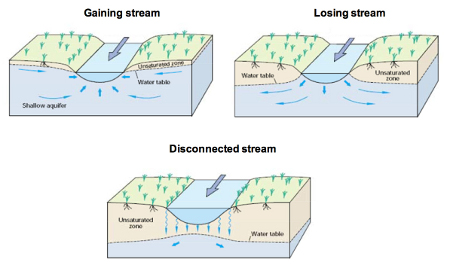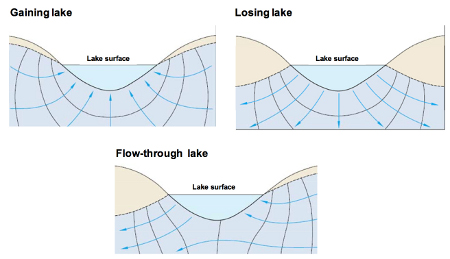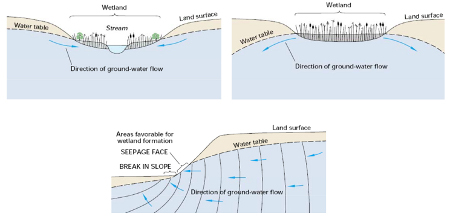How Does Groundwater Interact with the Surface Environment?
How Does Groundwater Interact with the Surface Environment?
Groundwater Interaction and Streams
As indicated by the hydrologic cycle, groundwater interacts with the surface water environment (including streams and rivers that drain the landscape, lakes and wetlands) that hold and store water that supports important ecosystems. Generally, the interaction with these systems takes place in three ways:
- Streams gain water from inflow of groundwater through the streambed (gaining stream)
- Streams lose water to groundwater by outflow through the streambed (losing stream)
- Streams both lose and gain water from groundwater discharge along various reaches
This interaction is shown in the diagram above. For groundwater to discharge into a stream channel, the elevation of the water table in the vicinity of the stream must be higher than the elevation of the stream-water surface.
The opposite holds true for a losing stream. Losing streams can be connected to the groundwater system by a continuous saturated zone or can be disconnected from the groundwater system by an unsaturated zone.
Groundwater Interaction and Lakes
With respect to lakes, groundwater interacts with these features in three ways:
- Groundwater inflow (gaining lake)
- Seepage loss to the saturated zone (losing lake)
- Groundwater inflow in certain parts and seepage loss from others (flow-through lake)
Although the basic interactions are the same for lakes as they are for streams, the interactions differ in several ways. The water level of natural uncontrolled lakes generally does not change as rapidly as the water level of streams.
Evaporation has the greatest natural effect on lake levels but water withdrawals, either through direct off-take of pumping of shallow groundwater nearby, can also effect a change in lake water levels by directly lowering levels or encouraging enhancing seepage loss.
Groundwater Interaction and Wetlands
Wetlands exist in areas where groundwater discharges to the land surface or on landscapes that prevent rapid drainage of water from the surface.
Wetlands can receive groundwater inflow, recharge the groundwater system, or do both. Wetlands that occupy depressions in the land surface have interactions with groundwater similar to lakes and streams. Unlike lakes and streams, wetlands do not always occupy low points and depressions in the landscape. They also can be present on slopes (such as fens) or even on drainage divides (such as some types of bogs). The different types of wetlands include fens, bogs and swamps/marshes.
Wetland areas can also gain or lose water much like lakes. In areas of steep terrain, the water table sometimes intersects the land surface, resulting in groundwater discharge directly to the land surface.
If the discharge is a sustained flow, it is referred to as a spring. Conversely, if the rate of evaporation is nearly equal to the rate of delivery then it may only manifest as a wet patch, or seep. The constant source of water to these features supports the growth of wetland vegetation.
Section 1: Introduction
Module 1: What is groundwater?
Module 2: What is an aquifer?
Module 3: How does groundwater move?
Module 4: What is the role of groundwater in the hydrological cycle?
Module 5: How does groundwater interact with the surface environment?



